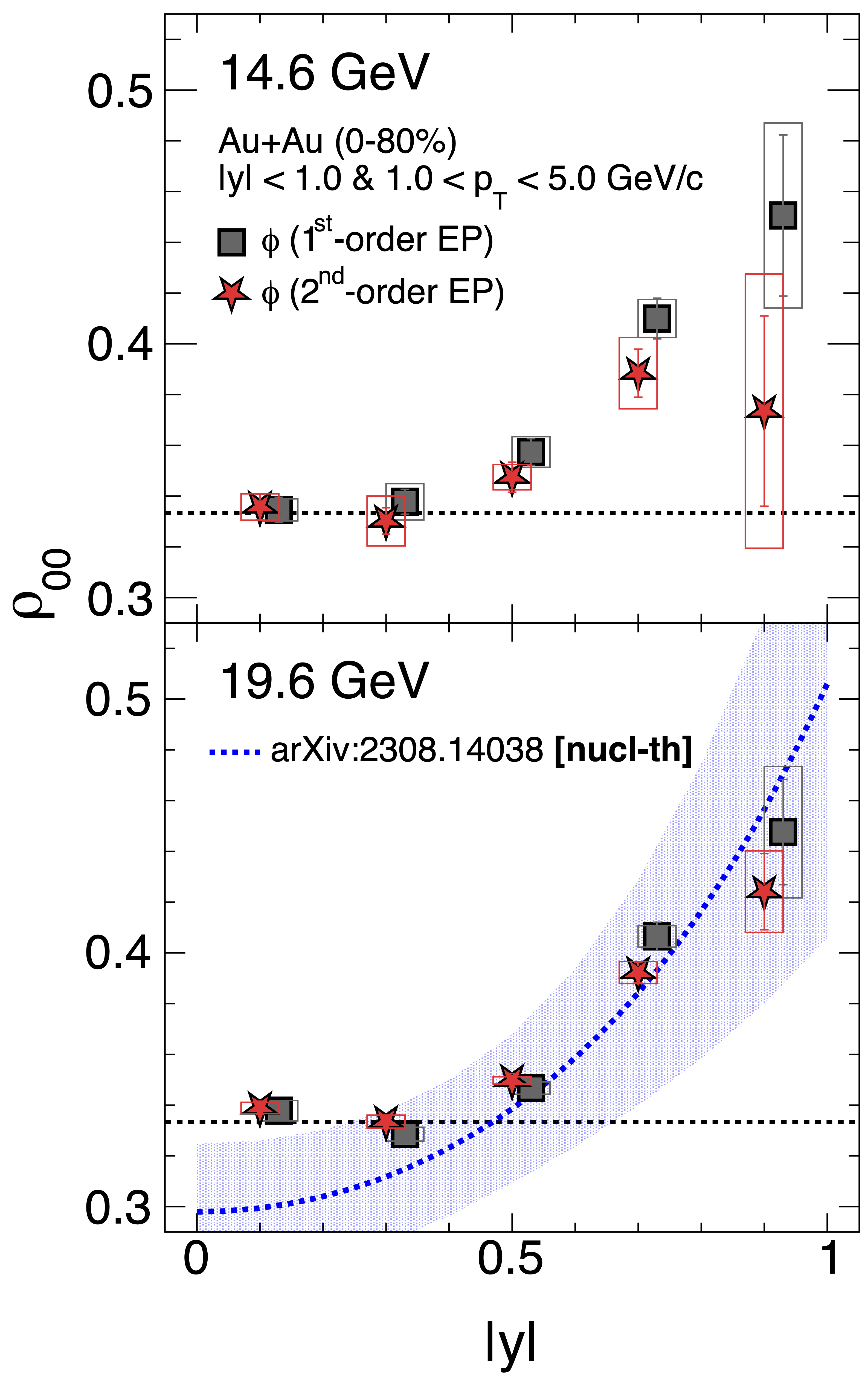Differential Measurements of $\phi$-meson Global Spin Alignment Paper Proposal
Title: Differential measurements of $\phi$-meson global spin alignment in Au+Au collisions at RHIC
PAs: Diyu Shen (Fudan), Xu Sun (IMP), Aihong Tang (BNL), Gavin Wilks (UIC), and Zhenyu Ye (UIC)
Proposed Target Journal: Physical Review Letters
Abstract Paragraph:
In this Letter, we report differential measurements of $\phi$-meson global spin alignment ($\rho_{00}$) in Au+Au collisions at $\sqrt{s_{NN}}$ = 14.6 and 19.6 GeV in the second phase of the Beam Energy Scan at RHIC (BES-II) using the STAR detector. Following the STAR observation of $\rho_{00}>1/3$ for the $\phi$-meson at $\sqrt{s_{NN}}\leq62.4$ GeV from BES-I [1], this study aims to clarify the source of this $\rho_{00}$ signal in the $\phi$-meson phase space using increased statistics available from BES-II. The first rapidity ($y$) dependent $\rho_{00}$ results for $\phi$-mesons are shown for $\sqrt{s_{NN}}$ = 14.6 and 19.6 GeV, in addition to new centrality and transverse momentum $(p_{T})$ dependent measurements. After developments of a theoretical model with a connection to strong force fields [2-6], predictions of the rapidity dependence at $\sqrt{s_{NN}}$ = 19.6 GeV were calculated in [7] and are consistent with our measurements. The results reported in this Letter help solidify our understanding of $\rho_{00}$ as a proxy measurement of vector meson fields, crucial components of the nuclear force. FCV PWG Paper Proposal / PWGC Paper Proposal slides: STAR/system/files/userfiles/6551/PWGC_Preapproval_v4.pdf

Figure 1. Collision energy ($\sqrt{s_{NN}}$) dependent $\rho_{00}$ for 20-60% centrality Au+Au collisions using first (top) and second (bottom) order event planes. The BES-II results are slightly shifted horizontally. The vertical lines are statistical uncertainties and boxes represent systematic uncertainties. A fit to BES-I measurementsbetween $\sqrt{s_{NN}} = 19.6 to 200 GeV is shown as a solid black curve, based on theoretical calculations in [2-6]. $G^{(y)}_{s}$ is thefitted parameter and is displayed with uncertainty. The black dashed line represents $\rho_{00}=1/3$.
.png)
Figure 2. Transverse momentum ($p_{T}$) dependent $\rho_{00}$ with respect to the first and second order event planes for 20-60% centrality Au+Au collisions at $\sqrt{s_{NN}}$ = 14.6 (top) and 19.6 (bottom) GeV. The first order event plane results are slightly shifted horizontally. The vertical lines are statistical uncertainties and boxes represent systematic uncertainties. The black dashed line represents $\rho_{00}=1/3$.
.png)
Figure 3. Centrality dependent $\rho_{00}$ with respect to the first and second order event planes for Au+Au collisions at $\sqrt{s_{NN}}$ = 14.6 (top) and 19.6 (bottom) GeV. The first order event plane results are slightly shifted horizontally. The vertical lines are statistical uncertainties and boxes represent systematic uncertainties. The black dashed line represents $\rho_{00}=1/3$.
![]()
Figure 3. Rapidity ($\vert y \vert$) dependent $\rho_{00}$ for 0-80% centrality Au+Aucollisions at $\sqrt{s_{NN}}$ = 14.6 (top) and 19.6 (bottom) GeV. Results for $\rho_{00}$ calculated with respect to the first and second order event plane are shown. The first order event plane results are slightly shifted horizontally. The vertical lines are statistical uncertainties and boxes represent systematic uncertainties. The theoretical prediction from [7] for 20-60% centrality and $p_{T}$=[1.2,5.4] GeV/c is shown as a dashed blue line with a shaded band representing its uncertainty. The black dashed line represents $\rho_{00}=1/3$.
[1] STAR Collaboration. Nature \textbf{614}, 244–248 (2023)
[2] X.L. Sheng et al. PRD \textbf{101}, 096005 (2020).
[3] X.L. Sheng et al. PRD \textbf{105}, 099903 (2022).
[4] X.L. Sheng et al. PRD \textbf{102}, 056013 (2020).
[5] X.L. Sheng et al. arXiv:2206.05868 \textbf{[hep-ph]} (2023).
[6] X.L. Sheng et al. PRL \textbf{131}, 042304 (2023).
[7] X.L. Sheng et al. arXiv:2308.14038 \textbf{[nucl-th]} (2023)
- gwilks3's blog
- Login or register to post comments

